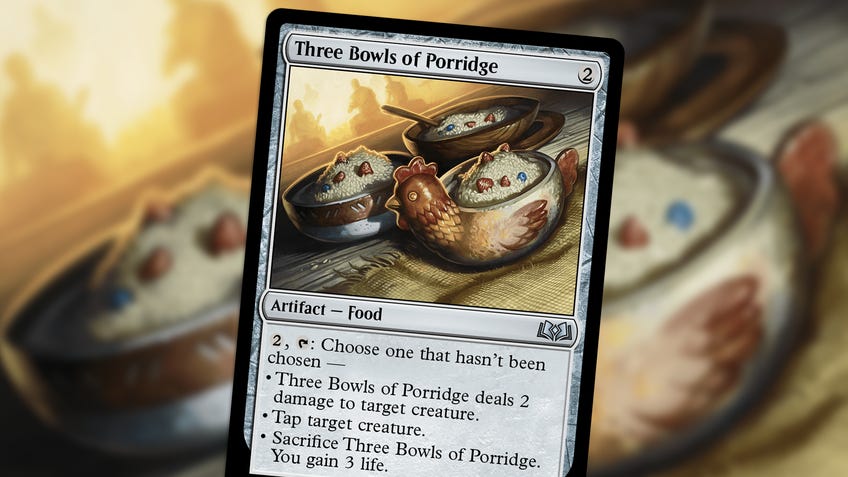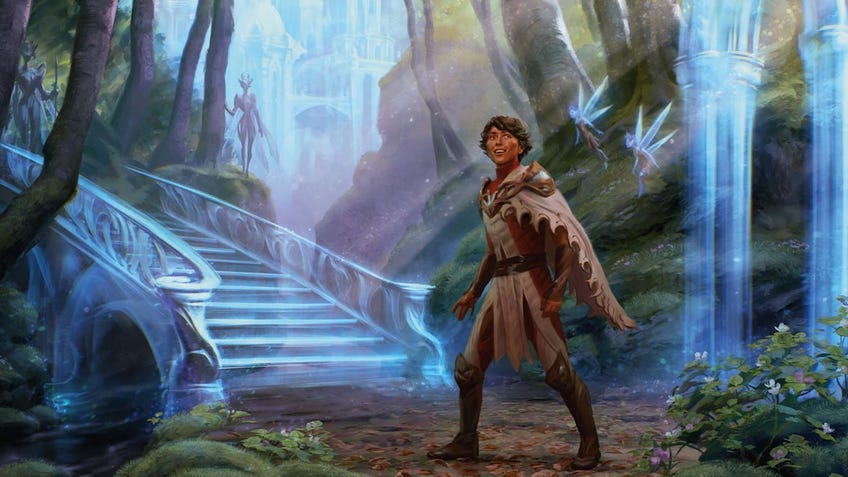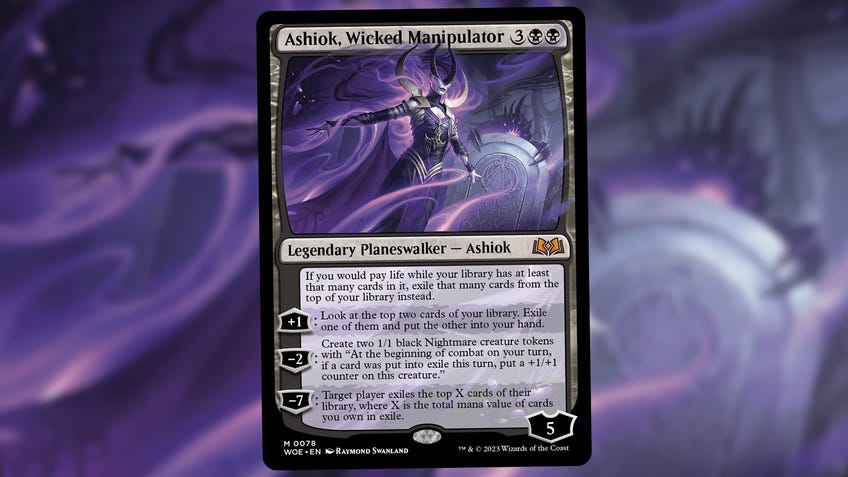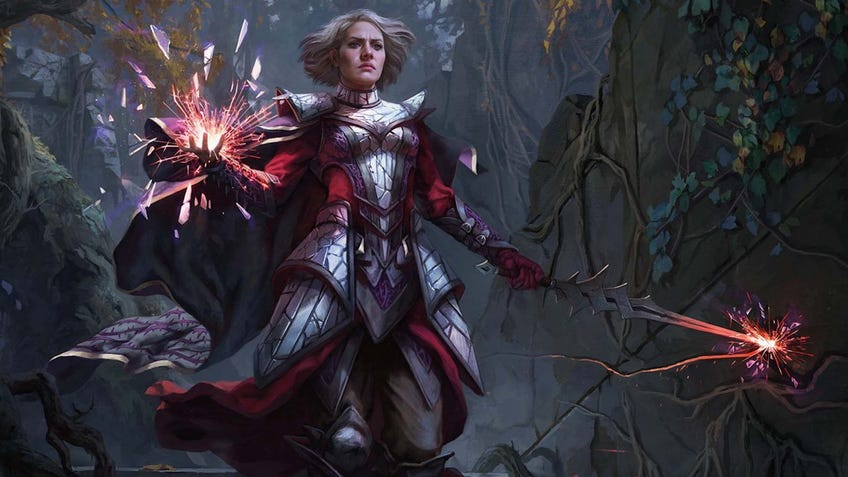Wilds of Eldraine is a triumph of fairy tale card design and the first set in new era of Magic: The Gathering
Putting the magic in Magic.
Wilds of Eldraine feels like our first standard Magic: The Gathering set in forever, yet it’s only been five months since March of the Machine and just four since The Aftermath. Since then, we’ve had the excellent Tales from Middle-Earth and the cash-hungry Commander Masters, but neither was Standard-legal.
Standard is, theoretically, the MTG format that most players get involved with first. To have a complete void of new cards there for such a long period of time feels like an incredibly odd choice given how frequently we get MTG sets.
The good news is that Wilds of Eldraine seems like a very strong set, both in terms of flavour and card design. While Standard players have been languishing with a format that’s been without new cards for a few months, this set should be like a true love’s kiss for it and help bring it back to life. It’s not dead, but the analogy was important.
It’s important to note that this is only the second time we’ve been to Eldraine, the MTG plane filled with classic fairy tale-inspired characters, with the first time being back in 2019’s Throne of Eldraine. The setting is one that almost feels like a Universes Beyond addition, because you get characters like Snow White and Red Riding Hood represented here in all but name.
Wilds of Eldraine should be like a true love’s kiss for Standard.
While seeing familiar characters is cool and all, no Wilds of Eldraine card represents the fusion of these stories and Magic: The Gathering quite as well as a two-mana artifact called Three Bowls of Porridge. Three Bowls of Porridge has three abilities; you can use each of them once. Paying two mana and tapping it allows you to choose one of the three abilities that you’ve not used yet.
The first ability allows it to deal two damage to a creature, representing the bowl of porridge that’s too hot, because fire in MTG deals damage. The second ability allows you to tap a target creature, which represents the bowl that’s too cold, as ice tends to tap things. The final ability has you sacrifice the artifact to gain three life, because the bowl of porridge is just right, and food in MTG gives you three life.

While calling something perfect is probably a bit much, it’s hard to overstate how exceptional this card design is, and it’s literally just for porridge. Each ability is well thought-out and apt, and anyone reading the card automatically thinks of Goldilocks. Even if the rest of Wilds of Eldraine was shockingly bad, this card would still shine as an example of its all-encompassing fantastic card design.
Thankfully, the rest of the set is just as good. A lot of that is thanks to Wilds of Eldraine's mechanics. First of all, we have the return of adventures. These are cards that also have an instant or sorcery on them that you can cast, which will put that card into exile, and then you can cast the normal version of that card from there. You can also just cast the normal version without casting the adventure. These allowed for some potent deck builds in the original set, and we’re glad to see them back again.

Next is celebration. Celebration is key because this is the first set we’ve had that’s lore-relevant since March of the Machine, and the first since the Phyrexians were defeated. This ability triggers when two or more nonland permanents have entered the battlefield under your control during a turn, and tends to lean towards buffing up your creatures to allow for bigger attacks.
Then we’ve got bargain, a mechanic that lets you upgrade a spell by sacrificing an artifact, enchantment or token. Being able to upgrade cards makes for more interesting moment-to-moment decisions and plays into the final new mechanic in Wilds of Eldraine: role tokens.
Role tokens are token aura enchantments that can go on a creature. Each creature can only have one at a time, with the newest token being the one that remains if you put a new one on. These enchantments tend to be buffs, but one actually sets a creature’s base power and toughness to 1/1, which is a great way to make a big enemy threat into something more manageable.
Wilds of Eldraine is the first set with only one planeswalker since their introduction 16 years ago.
There’s also something akin to a mechanic, but it’s more of a design change than anything. That’s the fact that Wilds of Eldraine is the first set with only one planeswalker since their introduction 16 years ago. This is to demonstrate that planeswalkers are back to being truly legendary beings again due to a big desparking during March of the Machine.
Wilds of Eldraine’s lone walker is Ashiok, Wicked Manipulator. This version of Ashiok is a five-mana Black planeswalker with five loyalty that can let you look at the top two cards of your library, exile one and put the other in your hands, can create tokens that get stronger if you’ve exiled a card each turn, and lets you exile cards from a player’s library equal to the mana value of the cards you own that are in exile. Along with that, Ashiok also has a passive ability that reads: “If you would pay life while your library has at least that many cards in it, exile that many cards from the top of your library instead.”

Basically, there’s a very strong theme here. Being able to whittle down your own library sets up some entertaining combinations in Commander, too. It definitely helps make Ashiok, Wicked Manipulator feel more worthy of focus than when we got tens of planeswalkers per set. Despite being powerful, it doesn’t feel overly so on its own.
With the planeswalker change, the amazing setting, the great card designs and the fun new mechanics, Wilds of Eldraine feels refreshing. Magic: The Gathering is having a good, albeit very busy year. We’re coming in incredibly hot on the heels of Commander Masters, which frankly left us feeling a little deflated, to say the least. WIlds of Eldraine is a reminder that MTG is still a good game, even if there is a lot of it.









